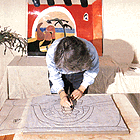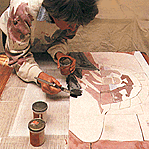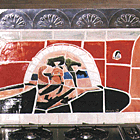Tile as Art — Art as Tile
|
 |
Sooner or later everything in New Mexico,
even the most mundane household decoration or functional surface,
is touched by an artist's hand. With that touch the ordinary
can be transformed into something extraordinary . . . a one-of-a-kind,
or even once-in-a-lifetime creation. Ceramic tiles fit into this
category . . . functional, extremely durable and truly an art
form.
Throughout the world one can find handmade
tiles . . . from Mexican saltillos to exquisite porcelain tiles
that encase Swedish woodstoves. In Santa Fe, New Mexico we discovered
a collaboration between the makers of handmade ceramic tiles
and an accomplished watercolorist. The results of the collaboration
are original paintings rendered in glazes on ceramic tile. It
doesn't seem like such a big deal, right? Wrong. The process
is more complicated than merely applying paint to tiles and there
are the inherent risks of breakage and surprises in the kiln.
In order to understand the merging of clay
and painting, we followed Santa Fe artist Elaine Holien through
the process of creating, on tile, a design similar to an original
watermedia painting entitled "Patzcuaro." The painting was redesigned
by Elaine to fit in a kitchen wall, surrounded by a field of
handmade white tiles from Counterpoint Tile in Santa Fe.
|

Elaine Holien
transfers a design
onto a slab of wet clay
Original painting is behind her.
|
|
The process begins with slabs of clay rolled
out like enormous pieces of dough. Pressing into the wet clay
with a blunt stylus, Elaine transfers the design from a sketch
traced on glassine a sturdy tracing paper. While the clay is
still wet, the slab is sliced into jigsaw-puzzle shapes. The
artist usually follows color boundaries but avoids eccentric
shapes which could hinder the drying process and cause warping.
Before proceeding further, the clay pieces must air dry for ten
days to two weeks. During that time, the clay is kept covered
with plastic and periodically flipped to insure steady and even
drying. Occasionally a section of clay must be sprayed with water
if that portion is drying too fast. While the tiles are still
damp, numbers are engraved on the reverse of each tile to aid
the reassembling of the puzzle.
|
|
When the clay is completely air-dried, the pieces
are bisque-fired in the Counterpoint Tile kiln at 1940 degrees
F to 2035 degrees F for 10 to 15 hours. After the first firing,
the clay is hard, insoluble in water, and is ready to be glazed
after it has cooled to room temperature (usually 24 hours). The
cooling phase takes place in the kiln, for to remove the clay
prematurely or to expose it suddenly to cool air would cause
thermal shock and shattering of the tile.
|
|
For the uninitiated, applying glazes to the
tiles, which become the colors in the painting, can be a humbling
experience. The glaze, a silicate-based solution, is made of
glass or a glass matrix and is both protective and decorative.
Exposure to high temperatures recombines the silicate molecules
and forms the shiny surface typical of glazed tile. Knowledge
of the properties of each glaze is vital; some glazes burn out
in very high temperatures and, most disconcerting of all, once
fired the colors of all glazes change to a greater or
lesser degree. Once the glazes have been applied and air-dried,
the tiles are refired to 1845 degrees F for another 10 to 15
hours.
|

|
Applying glazes
before final firing
|
|

|
The finished piece
installed and grouted,
as a cook top backsplash
|
|
Finally, the moment of truth. If the fired tiles
display the colors expected by the artist and none has broken
or warped, the tiles are reassembled, mounted on the wall with
mastic and grouted. The result is an original painting, more
durable than paper or canvas, and literally set in stone.
Since the completion of "Patzcuaro" in tile, Elaine Holien has
created other paintings in collaboration with Counterpoint, including
one which will be set in a frame, and therefore more portable
than those set for eternity in the surface of a Collector’s home.
For art lovers and collectors of original artwork,
a painting in ceramic tiles can be an ingenious solution to a
troublesome spot in need of artwork! The tiles' shiny surface
and imperviousness to heat and cold, rain or direct sunlight
insures a long-lasting treasure.
|
By Pamela Michaelis, founder of The Collector's Guide and former host of “Gallery News” radio show on KHFM 95.5  , classical radio in Albuquerque. Photographs by Thomas Holien. , classical radio in Albuquerque. Photographs by Thomas Holien.
Originally appeared in
The Collector’s Guide to Santa Fe and Taos - Volume
5
|
|



